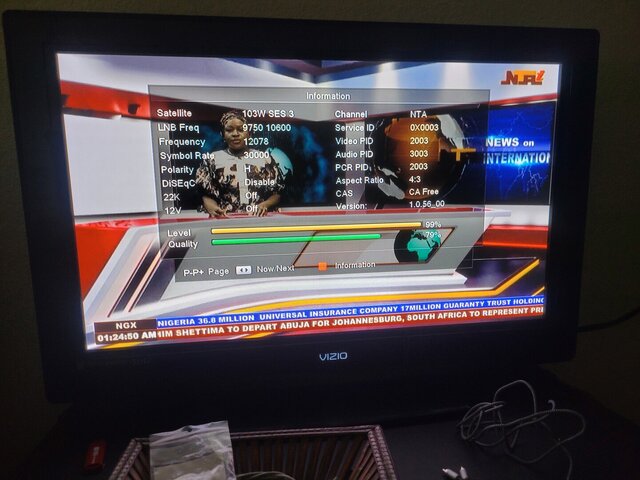Hi
I would need the help of a good Samaritan!!!
I'm struggling to lock the transponder 19 at SES3 (12080 H 29970 3/4). The Transponder 22 is a piece of cake (12145 V 20000 3/4). With this last one I get a SNR of 93% 14.2 dB, AGC of 100%. But for transponder 19, after a fine manual tuning of Azimuth, Elevation and skew I get roughly a SNR of 67%, 10 dB with a AGC of 97%, so the signal is coming and going constantly (pixeling and not locking).
My setup for this satellite is a fixed 90 cm (36") dish (an old DirecTV dish modified to work with a universal LNB). The LNB is a GeoSat Pro UL1PLL.
I've seen a post where a member compared 8 different types of LNBs and the signal this member gets using the same size dish, but different LNBs manufacturers, is a SNR of 12 dB for Transponder 19 and 15 dB for transponder 22. This user is located in Connecticut, I'm in south Florida, according to Lingsat we are in the same footprint with a power of 48 dBW (60 - 75 cm recommended dish).
I'm thinking to get another type of LNB, maybe an Inverto Ultra black model from Europe, to improve the SNR.
I do not understand why such difference in SNR values between Transponder 19 and 22. I have noticed that the Transponder 19 is quite sensible to the LNB skew.
Could it be that although the dish is a 90 cm one (36"), it was designed for the DirecTV LNB and is not "illuminating" correctly the GeoSat LNB? I tried 4 different GeoSat LNB and the result are almost the same.
Thanks in advance!!
I would need the help of a good Samaritan!!!
I'm struggling to lock the transponder 19 at SES3 (12080 H 29970 3/4). The Transponder 22 is a piece of cake (12145 V 20000 3/4). With this last one I get a SNR of 93% 14.2 dB, AGC of 100%. But for transponder 19, after a fine manual tuning of Azimuth, Elevation and skew I get roughly a SNR of 67%, 10 dB with a AGC of 97%, so the signal is coming and going constantly (pixeling and not locking).
My setup for this satellite is a fixed 90 cm (36") dish (an old DirecTV dish modified to work with a universal LNB). The LNB is a GeoSat Pro UL1PLL.
I've seen a post where a member compared 8 different types of LNBs and the signal this member gets using the same size dish, but different LNBs manufacturers, is a SNR of 12 dB for Transponder 19 and 15 dB for transponder 22. This user is located in Connecticut, I'm in south Florida, according to Lingsat we are in the same footprint with a power of 48 dBW (60 - 75 cm recommended dish).
I'm thinking to get another type of LNB, maybe an Inverto Ultra black model from Europe, to improve the SNR.
I do not understand why such difference in SNR values between Transponder 19 and 22. I have noticed that the Transponder 19 is quite sensible to the LNB skew.
Could it be that although the dish is a 90 cm one (36"), it was designed for the DirecTV LNB and is not "illuminating" correctly the GeoSat LNB? I tried 4 different GeoSat LNB and the result are almost the same.
Thanks in advance!!



